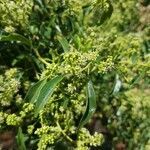Leaf-lamina (2·5)4·5–7(8–9) x (0·6) 1–2·2 cm., narrowly to broadly lanceolate, attenuate at the base into a canaliculate petiole up to 1 cm. long and at the apex into an acute tip, membranous to chartaceous, dull green above, light green below, sparsely appressed pilose on both surfaces, becoming glabrous when old; midrib grooved above, very prominent beneath, lateral nerves inconspicuous or sometimes with 1 prominent pair, reticulation close and very conspicuous, usually with a gland-dot in each mesh.
Cymes paniculate, the male panicles longer and broader than the female; inflorescence axis and pedicels ± sparsely appressed-pilose; bracteoles minute, up to 1 mm. long, carinate, appressed-pilose and gland-dotted outside; pedicels c. 2 mm. long.
female flower: perianth as in male; staminodes c. 1 mm. long; ovary subglobose, c. 1·25 in diam., usually bilobate, gland-dotted outside; style c. 2 mm. long, glabrous; stigma capitate, papillose.
A tree. It grow 20 m tall. The bark flakes off to expose smooth, orange new bark. The leaves have oil cavities. Crushed leaves have a smell.
Seeds ± straight, the outer ones c. 1·75 x 0·75 mm., ± winged at both ends.
Capsule subglobose or ellipsoid, 2–3 x 1·75–2 mm., gland-dotted.
Tree up to 10 m. high or shrub, with whitish bark.


